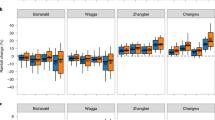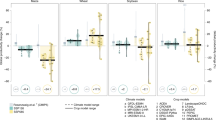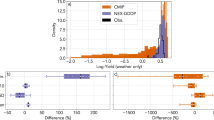Abstract
Global gridded climate–crop model ensembles are increasingly used to make projections of how climate change will affect future crop yield. However, the level of certainty that can be attributed to such simulations is unknown. Here, using currently available geospatial datasets and a widely employed simulation procedure, we created a wheat model ensemble of 1,440 global simulations of 20 climate scenarios, 3 crop models, 4 parameterization strategies and 3 management inputs of sowing date. We quantified the contributions of climate, model, parameterization and management to the overall uncertainty to predicted responses of yield to warming, then related the results to the latitude of the grid cells. For all warming scenarios, the total uncertainty for mid- and high latitudes is much larger than for low latitudes. Uncertainty arising from crop models was larger than that from the other sources combined. Parameterizing crop models with grid-specific information on wheat cultivars tended to decrease the crop model uncertainty, particularly for low latitudes. Crop model improvements and better-quality spatial input data more closely representing the wide range of growing conditions around the world will be needed to reduce the uncertainty of climate change impact assessment of crop yields.
This is a preview of subscription content, access via your institution
Access options
Access Nature and 54 other Nature Portfolio journals
Get Nature+, our best-value online-access subscription
$29.99 / 30 days
cancel any time
Subscribe to this journal
Receive 12 digital issues and online access to articles
$119.00 per year
only $9.92 per issue
Buy this article
- Purchase on Springer Link
- Instant access to full article PDF
Prices may be subject to local taxes which are calculated during checkout




Similar content being viewed by others
Data availability
All data supporting the simulation and analysis in this study are publicly available from open sources. The historical weather data (1981–2010) are available at https://data.giss.nasa.gov/impacts/agmipcf/; the future climate scenario data (2010–2099) are available at https://esgf-node.llnl.gov/projects/esgf-llnl/. Wheat mega-environment and definition are from https://data.cimmyt.org/dataset.xhtml?persistentId=hdl:11529/10625. The spatial data of harvest area, yield, crop calendar and irrigation portion are available at http://mapspam.Info/ (SPAM) and http://www.sage.wisc.edu (SAGE). Historical chemical nitrogen input of wheat is available at http://www.earthstat.org/nutrient-application-major-crops/. The soil data are available from the WISE database (https://www.isric.online/index.php/) and the Digital Soil Map of the World (DSMW). All other generated data (that is, model coefficients for the three crop models), simulation outputs (yield and phenology) and processed data for plotting the figures are available from the corresponding author on request.
References
Rosenzweig, C. et al. Assessing agricultural risks of climate change in the 21st century in global gridded crop model intercomparison. Proc. Natl Acad. Sci. USA 111, 3268–3273 (2014).
Deryng, D. et al. Global crop yield response to extreme heat stress under multiple climate change futures. Environ. Res. Lett. 9, 041001 (2014).
Folberth, C. et al. Uncertainty in soil data can outweigh climate impact signals in global crop yield simulation. Nat. Commun. 7, 11872 (2016).
Balkovič, J. et al. Global wheat production potentials and management flexibility under the representative concentration pathways. Glob. Planet. Change 122, 107–121 (2014).
Xie, W. et al. Decreases in global beer supply due to extreme drought and heat. Nat. Plants 4, 964–973 (2018).
Müller, C. & Robertson, R. D. Projecting future crop productivity for global economic modeling. Agric. Econ. 45, 37–50 (2014).
Rӧtter, R. P., Carter, T. R., Olesen, J. E. & Porter, J. R. Crop–climate models need an overhaul. Nat. Clim. Change 1, 175–176 (2011).
Challinor, A., Martre, P., Asseng, S., Thornton, P. & Ewert, F. Making the most of climate impacts ensembles. Nat. Clim. Change 4, 77–80 (2014).
Asseng, S. et al. Uncertainty in simulating wheat yields under climate change. Nat. Clim. Change 9, 827–832 (2013).
Martre, P. et al. Multimodel ensembles of wheat growth: many models are better than one. Glob. Change Biol. 21, 991–925 (2015).
Li, T. et al. Uncertainties in predicting rice yield by current crop models under a wide range of climatic conditions. Glob. Change Biol. 21, 1328–1341 (2015).
Tao, F. et al. Contribution of crop model structure, parameters and climate projections to uncertainty in climate change impact assessment. Glob. Change Biol. 24, 1291–1307 (2018).
Wang, E. et al. The uncertainty of crop yield projections is reduced by improved temperature response functions. Nat. Plants 3, 17102 (2017).
Deryng, D. et al. Regional disparities in the beneficial effects of rising CO2 concentrations on crop water productivity. Nat. Clim. Change 6, 786–790 (2016).
Elliott, J. et al. The global gridded crop model intercomparison: data and modeling protocols for phase 1 (v1.0). Geosci. Model Dev. 8, 261–277 (2015).
Elliott, J. et al. The parallel system for integrating impact models and sectors (pSIMS). Environ. Model. Softw. 62, 509–516 (2014).
Asseng, S. et al. Climate Change impact and adaptation for wheat protein. Glob. Change Biol. 25, 155–173 (2019).
Jones, J. W. et al. The DSSAT cropping system model. Eur. J. Agron. 18, 235–265 (2003).
Asseng, S., Foster, I. & Turner, N. C. The impact of temperature variability on wheat yields. Glob. Change Biol. 17, 997–1012 (2011).
Trnka, M. et al. Adverse weather conditions for European wheat production will become more frequent with climate change. Nat. Clim. Change 4, 637–643 (2014).
Teixeira, E. I., Fischer, G., van Velthuizen, H., Walter, C. & Ewert, F. Global hot-spots of heat stress on agricultural crops due to climate change. Agric. For. Meteorol. 170, 206–215 (2013).
Ramirez-Villegas, J., Watson, J. & Challinor, A. J. Identifying traits for genotypic adaptation using crop models. J. Exp. Bot. 66, 3451–3462 (2014).
Iizumi, T., Tanaka, Y., Sakurai, G., Ishigooka, Y. & Yokozawa, M. Dependency of parameter values of a crop model on the spatial scale of simulation. J. Adv. Model. Earth Syst. 6, 527–540 (2014).
Ewert, F. et al. Scale changes and model linking methods for integrated assessment of agri-environmental systems. Agric. Ecosyst. Environ. 132, 6–17 (2011).
Lobell, D. B., Sibley, A. & Ortiz-Monasterio, I. Extreme heat effects on wheat senescence in India. Nat. Clim. Change 2, 186–189 (2012).
Keating, B. A. & Thorburn, P. J. Modelling crops and cropping systems—evolving purpose, practice and prospects. Eur. J. Agron. 100, 163–176 (2018).
Jin, X. et al. Review of data assimilation of remote sensing and crop models. Eur. J. Agron. 92, 141–152 (2018).
Ritchie, J. T., Singh, U., Godwin, D. C. & Bowen, W. T. in Understanding Options for Agricultural Production (eds Tsuji, G. Y. et al.) 79–98 (Kluwer Academic, 1998).
Hunt, L. A. & Pararajasingham, S. CROPSIM-WHEAT: a model describing the growth the development of wheat. Can. J. Plant Sci. 75, 619–632 (1996).
Zheng, B., Chenu, K., Doherty, A., Doherty, T. & Chapman, L. The APSIM-Wheat Module (APSRU, 2014).
Ruane, A. C., Goldberg, R. & Chryssanthacopoulos, J. AgMIP climate forcing datasets for agricultural modeling: merged products for gap-filling and historical climate series estimation. Agric. For. Meteorol. 200, 233–248 (2015).
Sacks, W. J., Deryng, D., Foley, J. A. & Ramankutty, N. Crop planting dates: an analysis of global patterns. Glob. Ecol. Biogeogr. 19, 607–620 (2010).
You, L. et al. Spatial Production Allocation Model 2005 V3.2 (MapSPAM, 2017).
Batje, H. N. A Homogenized Soil Data File for Global Environmental Research: A Subset of FAO, ISRIC and NRCS Profiles (Version 1.0) Working Paper and Preprint 95/10b (International Soil Reference and Information Centre, 1995).
Digital Soil Map of the World and Derived Soil Properties (FAO, 1996).
Schaap, M. G. & Bouten, W. Modeling water retention curves of sandy soils using neural networks. Water Resour. Res. 32, 3033–3040 (1996).
Boogaart, H. L. et al. User’s Guide for the WOFOST 7.1 Crop Growth Simulation Model and WOFOST Control Center 1.5 (DLO Winand Staring Centre, 1998).
Gbegbelegbe, S. et al. Baseline simulation of global wheat production with CIMMYT mega-environment specific cultivars. Field Crop. Res. 202, 122–135 (2017).
Aridia, D., Boudt, K., Carl, P., Mullen, K. M. & Peterson, B. G. Differential evolution with DEoptim: an application to non-convex portfolio optimization. R J. 3, 27–34 (2011).
Naab, J. B., Boote, K. J., Jones, J. W. & Porter, C. H. Adapting and evaluating the CROPGRO-peanut model for response to phosphorus on a sandy-loam soil under semi-arid tropical conditions. Field Crop. Res. 176, 71–86 (2015).
Dzotsi, K. A. et al. Modeling soil and plant phosphorus within DSSAT. Ecol. Model. 211, 2839–2849 (2010).
Harmonized World Soil Database Version 1.2 (FAO, 2010).
Acknowledgements
We thank J. Yang for help analysing data, and J. Yang and U. A. Schulthess for helpful comments. This work was directly supported by The National Science Foundation of China (grant nos 4147104 and 41171093). This study was also indirectly supported by the CGIAR research programme on wheat agri-food systems (CRP WHEAT) and the CGIAR Platform for Big Data in Agriculture, the World Bank and the Mexican government through the Sustainable Modernization of Traditional Agriculture (MasAgro) project. R. Robertson’s contributions were supported by the CGIAR Research Program on Policies, Institutions, and Markets.
Author information
Authors and Affiliations
Contributions
W.X. and S.A. conceived the study. W.X., I.H.-O., R.R., K.S., D.P., M.R. and B.G. implemented the experiment, W.X., S.A. and G.H. drafted the paper, and all contributed to the writing.
Corresponding author
Ethics declarations
Competing interests
The authors declare no competing interests.
Additional information
Publisher’s note Springer Nature remains neutral with regard to jurisdictional claims in published maps and institutional affiliations.
Supplementary information
Rights and permissions
About this article
Cite this article
Xiong, W., Asseng, S., Hoogenboom, G. et al. Different uncertainty distribution between high and low latitudes in modelling warming impacts on wheat. Nat Food 1, 63–69 (2020). https://doi.org/10.1038/s43016-019-0004-2
Received:
Accepted:
Published:
Issue Date:
DOI: https://doi.org/10.1038/s43016-019-0004-2



